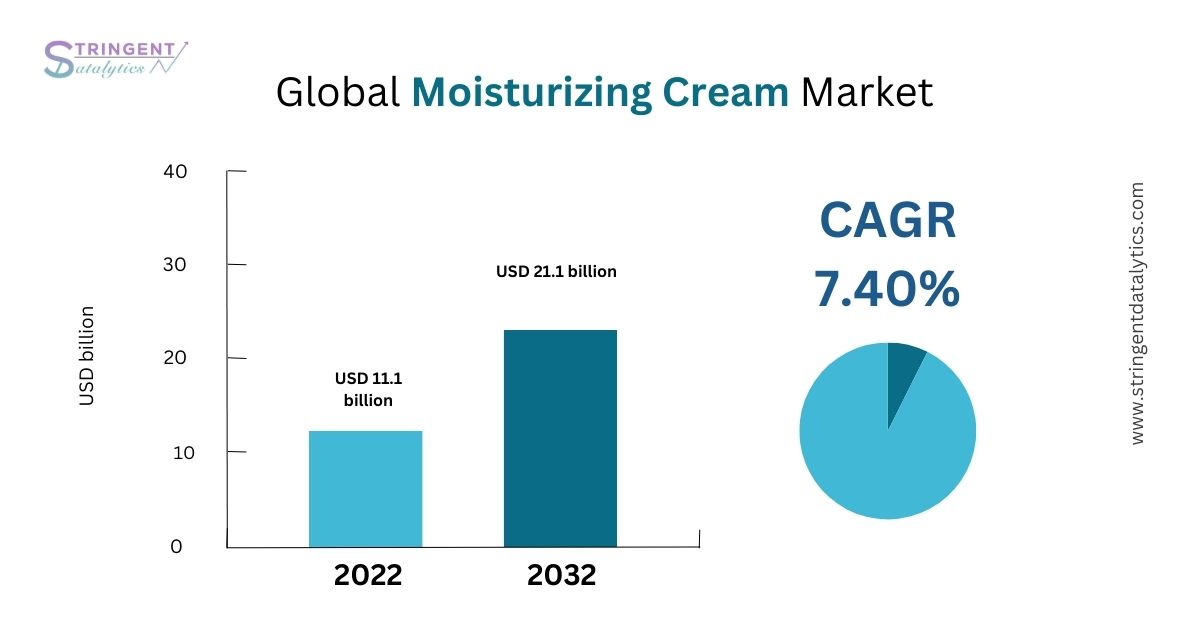Moisturizing Cream Market Size was evaluated at USD 11.1 billion in 2022 and is expected to rise at a compound annual growth rate (CAGR) of 7.40% between 2023 and 2032, from USD 11.9214 billion in 2023 to USD 21.1 billion by 2032.
In the realm of personal care products, moisturizing creams hold a significant position, catering to a diverse consumer base seeking hydration, rejuvenation, and protection for their skin. The Moisturizing Cream Market is a dynamic sector, characterized by innovation, evolving consumer preferences, and intense competition among brands. As the beauty and skincare industry continues to witness exponential growth globally, the moisturizing cream market stands as a pivotal segment driving revenue and consumer engagement.
Request Free Sample PDF @ https://stringentdatalytics.com/sample-request/moisturizing-cream-market/13290/
Key Challenges:
- Shifting Consumer Preferences: The moisturizing cream market is heavily influenced by changing consumer preferences driven by various factors such as evolving beauty trends, increasing awareness regarding skincare ingredients, and cultural influences. Manufacturers face the challenge of staying abreast of these shifting preferences and adapting their product formulations, marketing strategies, and packaging to resonate with consumers effectively.
- Rising Demand for Natural and Organic Products: With growing concerns about the use of synthetic chemicals and their potential adverse effects on skin health and the environment, there is a notable surge in demand for natural and organic moisturizing creams. This trend poses a challenge for manufacturers who must reformulate their products to incorporate natural ingredients while ensuring efficacy, stability, and shelf-life, all without compromising on product quality or affordability.
- Product Differentiation in a Saturated Market: The moisturizing cream market is saturated with numerous brands offering a wide array of products, making it increasingly challenging for manufacturers to differentiate their offerings. Establishing a unique selling proposition (USP) through innovative product formulations, packaging designs, and marketing campaigns becomes imperative to stand out in a crowded marketplace and capture consumer attention.
- E-commerce Disruption: The rise of e-commerce platforms has disrupted traditional retail channels, reshaping consumer purchasing habits and brand interactions. While e-commerce offers unparalleled reach and convenience, it also intensifies competition as brands vie for visibility and market share online. Manufacturers must navigate the complexities of digital marketing, optimize their online presence, and ensure seamless customer experiences to thrive in the digital landscape.
- Global Regulatory Compliance: The moisturizing cream market is subject to stringent regulations and standards imposed by regulatory bodies worldwide to ensure product safety, efficacy, and compliance with labeling requirements. Navigating the complex regulatory landscape across different regions poses a significant challenge for manufacturers, necessitating thorough understanding, meticulous testing, and documentation to obtain necessary approvals and certifications for market entry.
- Sustainability and Environmental Concerns: In an era marked by growing environmental consciousness, consumers are increasingly demanding sustainable and eco-friendly skincare products. Manufacturers face the challenge of reducing their environmental footprint by adopting sustainable sourcing practices, minimizing packaging waste, and incorporating biodegradable materials into product formulations, all while maintaining product performance and affordability.
- Price Sensitivity and Economic Uncertainty: Despite the growing demand for premium skincare products, price sensitivity remains a significant factor influencing consumer purchasing decisions, particularly in times of economic uncertainty. Manufacturers must strike a delicate balance between offering high-quality moisturizing creams at competitive prices while managing production costs, profit margins, and currency fluctuations to remain viable in a competitive market landscape.
- Innovating Amid Technological Advancements: Rapid technological advancements in skincare research and formulation techniques present both opportunities and challenges for manufacturers. While innovation enables the development of novel ingredients, delivery systems, and formulations that promise enhanced efficacy and consumer benefits, it also necessitates substantial investment in research and development (R&D), clinical testing, and regulatory compliance to bring innovative products to market successfully.
Market Segmentations:
Global Moisturizing Cream Market: By Company
• L’Oréal
• Johnson & Johnson
• Procter & Gamble
• Beiersdorf
• The Estée Lauder Companies
• Shiseido
• Aveeno
• Bioelements
• Chicco
• California Baby
• Earth Mama Angel Baby
• Cotton Babies
• Paula’s Choice
• Kate Somerville Skincare
• Dove-Unilever
• Origins Natural Resources
• Borghese
• Mario Badescu Skin Care
• Burt’s Bees
• La Prairie
(This is a tentative list, the report on delivery will have additional companies profiled with potential/new entrants within the major shareholder market : Please subscribe to the latest sample report to know more)
Global Moisturizing Cream Market: By Type
• Face Care
• Body Care
Global Moisturizing Cream Market: By Application
• Infants & Toddlers
• Children
• Adults
(This is a tentative list of segments, the most updated report upon date of purchase will have additional deep dive segments : Please subscribe to the latest sample report to know more)
Global Moisturizing Cream Market: Regional Analysis
The regional analysis of the global Moisturizing Cream market provides insights into the market’s performance across different regions of the world. The analysis is based on recent and future trends and includes market forecast for the prediction period. The countries covered in the regional analysis of the Moisturizing Cream market report are as follows:
North America: The North America region includes the U.S., Canada, and Mexico. The U.S. is the largest market for Moisturizing Cream in this region, followed by Canada and Mexico. The market growth in this region is primarily driven by the presence of key market players and the increasing demand for the product.
Europe: The Europe region includes Germany, France, U.K., Russia, Italy, Spain, Turkey, Netherlands, Switzerland, Belgium, and Rest of Europe. Germany is the largest market for Moisturizing Cream in this region, followed by the U.K. and France. The market growth in this region is driven by the increasing demand for the product in the automotive and aerospace sectors.
Asia-Pacific: The Asia-Pacific region includes Singapore, Malaysia, Australia, Thailand, Indonesia, Philippines, China, Japan, India, South Korea, and Rest of Asia-Pacific. China is the largest market for Moisturizing Cream in this region, followed by Japan and India. The market growth in this region is driven by the increasing adoption of the product in various end-use industries, such as automotive, aerospace, and construction.
Middle East and Africa: The Middle East and Africa region includes Saudi Arabia, U.A.E, South Africa, Egypt, Israel, and Rest of Middle East and Africa. The market growth in this region is driven by the increasing demand for the product in the aerospace and defense sectors.
South America: The South America region includes Argentina, Brazil, and Rest of South America. Brazil is the largest market for Moisturizing Cream in this region, followed by Argentina. The market growth in this region is primarily driven by the increasing demand for the product in the automotive sector.
Direct Order Can Be Placed Through This Link [Exclusive Copy]: @ https://stringentdatalytics.com/purchase/moisturizing-cream-market/13290/?license=single
Objectives of Moisturizing Cream Market Study:
- Market Trends Analysis: Identify and analyze key trends influencing the moisturizing cream market, such as consumer preferences, emerging ingredients, packaging innovations, and distribution channels.
- Competitive Landscape Assessment: Evaluate the competitive environment within the moisturizing cream market, including major players, their market share, strengths, weaknesses, and strategies.
- Consumer Behavior and Preferences: Understand consumer attitudes, behaviors, and preferences regarding moisturizing creams, including factors influencing purchasing decisions and brand loyalty.
- Segmentation and Targeting: Segment the market based on various factors such as product type, distribution channel, demographics, and geographic regions. Identify target market segments with the highest growth potential.
- Market Entry Opportunities: Identify opportunities for new entrants or existing players to enter or expand within the moisturizing cream market, including niche markets, untapped regions, and product innovation opportunities.
- Regulatory Environment Analysis: Understand the regulatory landscape governing moisturizing cream products, including compliance requirements, safety standards, and labeling regulations.
- Supply Chain Analysis: Evaluate the supply chain dynamics of moisturizing cream products, including raw material sourcing, manufacturing processes, distribution channels, and retailing.
- Price Analysis: Analyze pricing strategies employed by market players, including pricing trends, pricing elasticity, and price positioning relative to competitors.
- Forecasting and Future Outlook: Provide forecasts for the future growth and direction of the moisturizing cream market, considering factors such as economic conditions, consumer trends, technological advancements, and regulatory changes.
About US:
Stringent Datalytics offers both custom and syndicated market research reports. Custom market research reports are tailored to a specific client’s needs and requirements. These reports provide unique insights into a particular industry or market segment and can help businesses make informed decisions about their strategies and operations.
Syndicated market research reports, on the other hand, are pre-existing reports that are available for purchase by multiple clients. These reports are often produced on a regular basis, such as annually or quarterly, and cover a broad range of industries and market segments. Syndicated reports provide clients with insights into industry trends, market sizes, and competitive landscapes. By offering both custom and syndicated reports, Stringent Datalytics can provide clients with a range of market research solutions that can be customized to their specific needs.
Contact US:
Stringent Datalytics
Contact No – +1 346 666 6655
Email Id – sales@stringentdatalytics.com




Leave a Reply